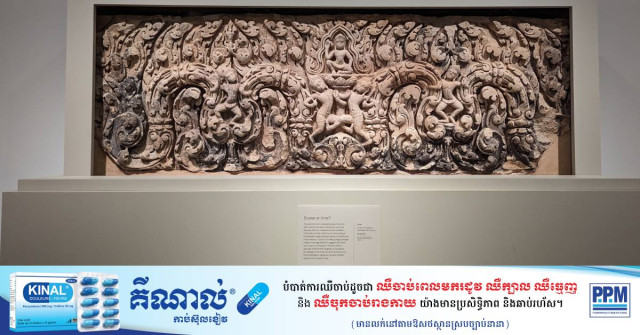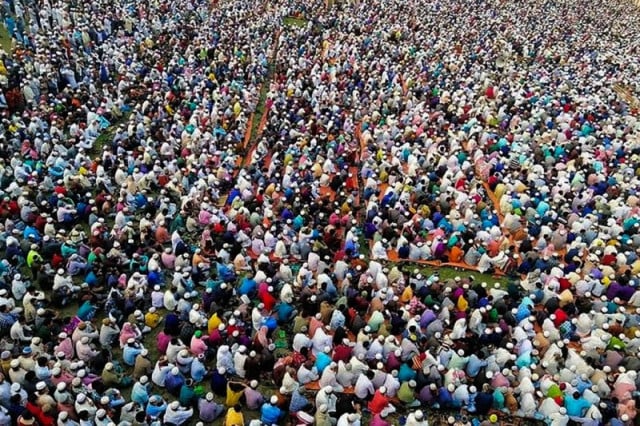Lost Khmer Sculptures’ Journey Intertwined with Complex History

- By Teng Yalirozy
- January 16, 2024 4:25 PM
PHNOM PENH – Accidentally unearthed after being buried in a rice field, long-lost ancient artifacts have found their way to the West. A curator of Southeast Asian art is trying to reveal the whereabouts of a collection of bronzes and sculptures believed to belong to the Khmer kingdom of long ago, now in the USA. But tracing their provenance is sometimes harder than it looks.
Emma Natalya Stein, a curatorial staff member at the Smithsonian’s National Museum of Asian Art who has traveled to Cambodia six times to learn about the sculptures and research their provenance, said she is involved in digging into the origin of the artworks as far back as possible to understand when and how they left the region.
The collection she’s working on includes a Khmer bronze found in southern Vietnam, which was excavated accidentally by a farmer and then traveled from Cambodia or Thailand to Vietnam before entering the international art market in the 1930s, she said.
The Smithsonian’s National Museum of Asian Art was opened in 1923, starting with the foundational collection of Charles Lang Freer – an American industrialist renowned for being a collector of Asian art – who gave his collection to the nation in 1906. The museum aims to enable visitors to experience and learn about the connection of the artwork around the world, both ancient and contemporary.
“We do have a substantial collection of South Asian and Southeast Asian art,” said Stein. “But our Southeast Asia collection is idiosyncratic. It contains about 900 objects, of which about 800 are ceramics.
“Indonesia and Cambodia are the strongest areas for Southeast Asian sculpture and ritual objects. But we still have a very small number of objects [from there].”
 Emma Natalya Stein is a curatorial staff member at the Smithsonian’s National Museum of Asian Art who has traveled to Cambodia six times to learn about the sculptures and research their provenance. Photo: Sem Vanna
Emma Natalya Stein is a curatorial staff member at the Smithsonian’s National Museum of Asian Art who has traveled to Cambodia six times to learn about the sculptures and research their provenance. Photo: Sem Vanna
Stein said the collection only contains seven sculptures, which are believed to have originated in Cambodia. Most of them are kept for study and research purposes while some are being displayed in the gallery.
She and her team actively research the provenance of the objects in their collection, with a focus on Cambodia. Four dedicated researchers work closely with curators of South and Southeast Asian art to trace the origins of such pieces of art and the journey they went through across changing hands.
The Khmer Empire, a highly sophisticated civilization
The origins of Cambodian artifacts are unclear, Stein pointed out. But she and her team use the 1970 UNESCO World Convention - a legal tool in the battle against theft and illegal trafficking - to trace ownership chains.
They also rely on a volume called the Global Lives of Objects, to trace back the journey of objects part of their collection.
For instance, a bronze sculpture that was made during the Bayon period (late 12th or 13th centuries), which is the greatest expansion of the Khmer Empire, could then have originated in what is now Cambodia, Northern Thailand, Laos or Southern Vietnam.
Small bronze sculptures were often carried over long distances by people who saw them as objects of devotion, she explained. Bronzes had to be officially reported and could serve as models for large-scale stone sculptures and temple architecture.
One day, a farmer found a group of seven eclectic bronzes, including Hindu and Buddhist deities, in an agricultural area. The bronzes were taken to Paris by a dealer, then to the U.S., where they were collected by Freer Gallery, she said.
“The Khmer Empire was a highly sophisticated civilization and the largest pre-industrial city on Earth,” she said. “So, these networks and patterns of movement were very tracked. However, there is still a point of transfer where it is hard to know exactly what happened, as there were no records in the way we would want them to be.”
The Khmer Empire (802-1431 AD) was a Southeast Asian state ruled by the Khmer ethnic group, spanning Cambodia, Laos, Thailand, and Vietnam. The empire thrived in Cambodia for 629 years, with Angkor kings maintaining their empire with canals, lakes, and spiritual statues, using more stone than all Egyptian pyramids combined. The empire saw a decline after the reign of King Jayavarman VII.
 The Goddess Prajnaparamita "Perfection of Wisdom" embodies the wisdom required for attainting enlightenment. It was originated in Cambodia and made around the year 1200. Photo: Sem Vanna
The Goddess Prajnaparamita "Perfection of Wisdom" embodies the wisdom required for attainting enlightenment. It was originated in Cambodia and made around the year 1200. Photo: Sem Vanna
The collection Stein is studying, including sculptures from 1939 and 1987, was added to the museum through a substantial gift from the Sackler Gallery, which was founded in 1987, along with a gift from another collection.
One of the Cambodian sculptures is a lentil in an exhibition called “The Art of Knowing,” whose origin remains a mystery as it may have been from a temple in northeastern Thailand or Cambodia.
The Smithsonian Museum of Art is focusing on preserving Cambodian art and antiquities, Stein said, adding that the museum does not want to collect on the looted objects. That’s the reason she and her team keep researching and learning about the provenance.
Digital exhibition
In 2022, the museum held a large exhibition entitled “Revealing Krishna's Journey to Cambodia's Sacred Mountain,” focusing on the sculpture of Krishna lifting Mount Garden from Phnom Da.
The exhibition was organized by the Cleveland Museum of Art and featured digital experiences that brought the landscape of Phnom Da into the gallery. This immersive performance allowed visitors to experience the sculpture as he stood in his cave halfway up the mountain.
 In 2022, the museum held a large exhibition entitled “Revealing Krishna's Journey to Cambodia's Sacred Mountain,” focusing on the sculpture of Krishna lifting Mount Garden from Phnom Da. Photo: Photo: The Cleveland Museum of Art
In 2022, the museum held a large exhibition entitled “Revealing Krishna's Journey to Cambodia's Sacred Mountain,” focusing on the sculpture of Krishna lifting Mount Garden from Phnom Da. Photo: Photo: The Cleveland Museum of Art
“Cambodian artworks are so deeply connected with their environment that tumbles it there,” said Stein. “A sense of context is often missing in traditional museum displays. So even by just focusing on one sculpture, we were able to share the power and the importance of Khmer art.”
The sculpture's appearance has resulted from an international collaboration between Cleveland and the National Museum in Phnom Penh, who exchanged fragments of the sculpture and reconstructed them properly.
“This collaboration aims to share the power and importance of Cambodian art and the connection it provides to its environment,” she said.
Culture Minister Phoeurng Sackona last August said that the U.S. and Cambodia have been working on cultural cooperation for 20 years. The U.S. has returned about 100 looted artifacts to Cambodia and increased the ability of Cambodians to protect their cultural heritage.
For decades, Cambodia’s cultural artifacts have been looted and acquired by private collectors and museums around the world, especially in the U.S., Europe, Australia and even Asia.
Preserving the long-standing historic temples
In 1989, the World Monuments Fund went to Cambodia after the civil war, partnering with the Royal University of Fine Arts to develop conservation training opportunities.
They began working at Preah Khan Temple, one of the largest temples at the Angkor Archaeological Park, bringing international experts and local students, said Vice President of Programs Jonathan S. Bell.
 Jonathan S. Bell is a Vice President of Programs at the World Monuments Fund. He gave the interview to Cambodianess in December, 2023 in New York City. Photo: Sem Vanna
Jonathan S. Bell is a Vice President of Programs at the World Monuments Fund. He gave the interview to Cambodianess in December, 2023 in New York City. Photo: Sem Vanna
Over time, these students became full-fledged professionals, running their own projects and becoming full staff of the World Monuments Fund. Since then, they have worked on projects on Preah Khan, Angkor Wat's churning of the ocean of milk Gallery, and bigger projects like the Bakheng temple.
Over the past 35 years, the organization has been in Cambodia, employing 80-100 full-time staff annually. They have trained these professionals, contributing significantly to the local economy as over $20 million has been spent on projects, with $15 million of them staying in Cambodia, Bell claimed.
“We've done this calculation where we realize now that the equivalent of that money is like supporting 10,000 people for one year,” he said. “That money has gone a long way and has made a huge contribution to the local economy. And that's something that we're trying to parse out and understand what that real impact has been.”
However, Bell acknowledged the need for more work in conservation, even in areas with high expertise, proposing to create a training program for site managers and a certificate program with the Royal University of Fine Arts to fill the gap in conservation education in Cambodia.
“This will help create a standard and impact, while also addressing the lack of professional training programs in the field,” he said.
Protecting cultural heritage is crucial as it has tangible ties to its associated people, Bell said. If wrongly acquired or questions arise, the looted relics should be returned to the people.
“Some objects have been returned, and it's exciting for local partners to see the heritage restored, helping to make the place whole again,” he said.















